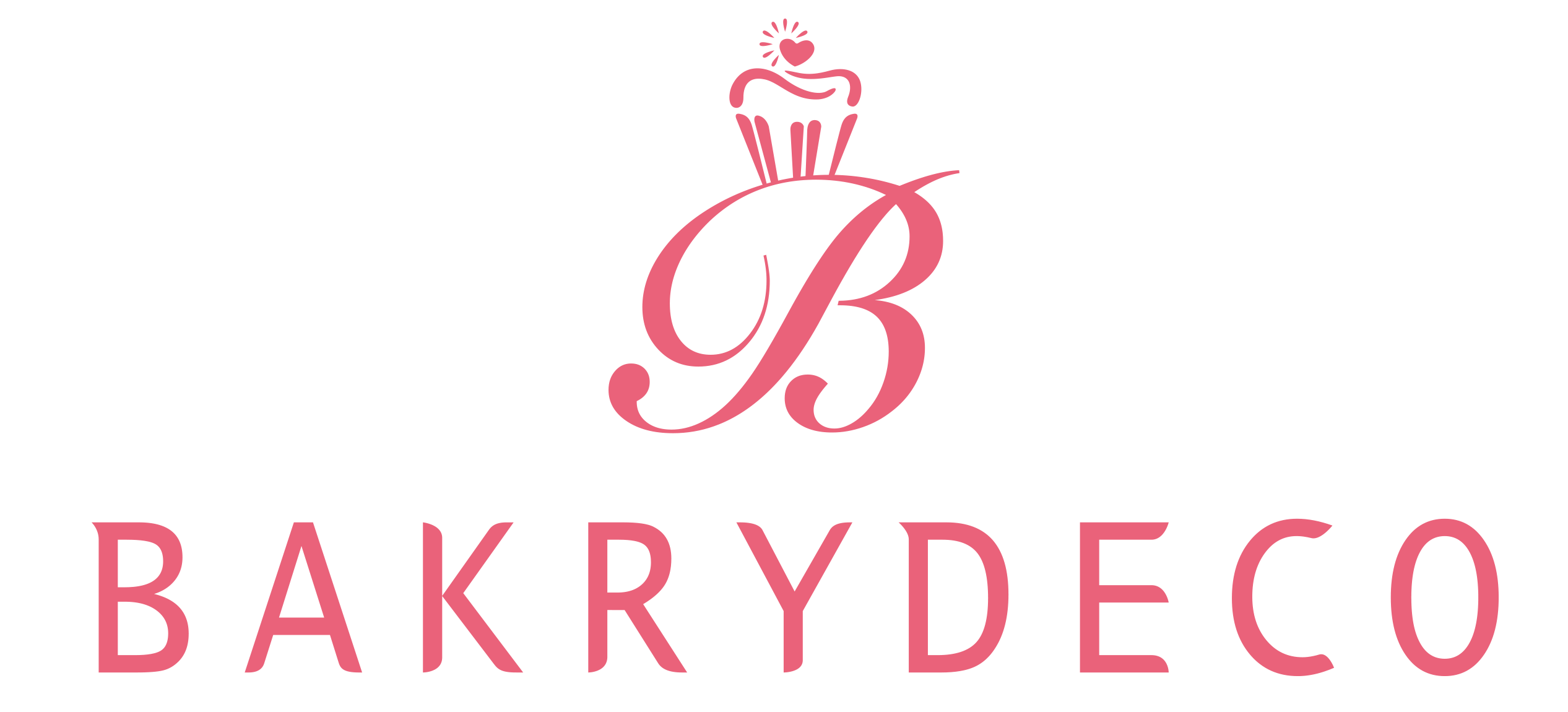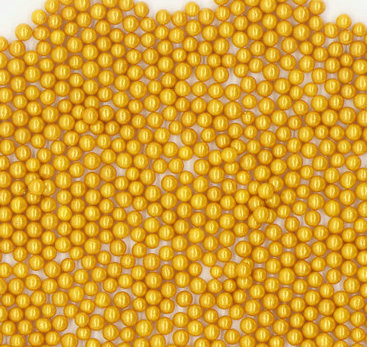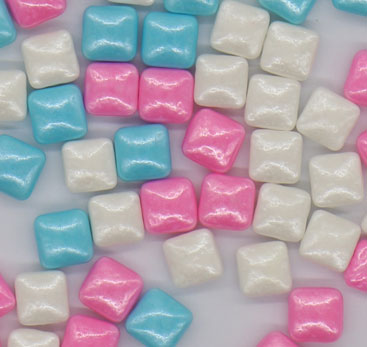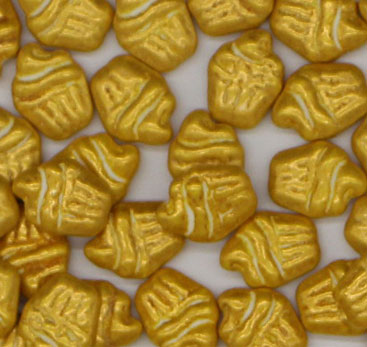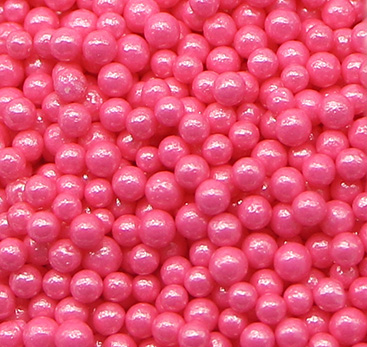You most likely met nonpareil sprinkles if you have loved a cupcake, holiday cookie, or doughnut topped with sprinkles. Along with a decorative flourish, these small, vibrant sweets give desserts a distinctive texture. But mainly, what are nonpareils, and how different are they from other sprinkles? Let us tour this sweet planet.
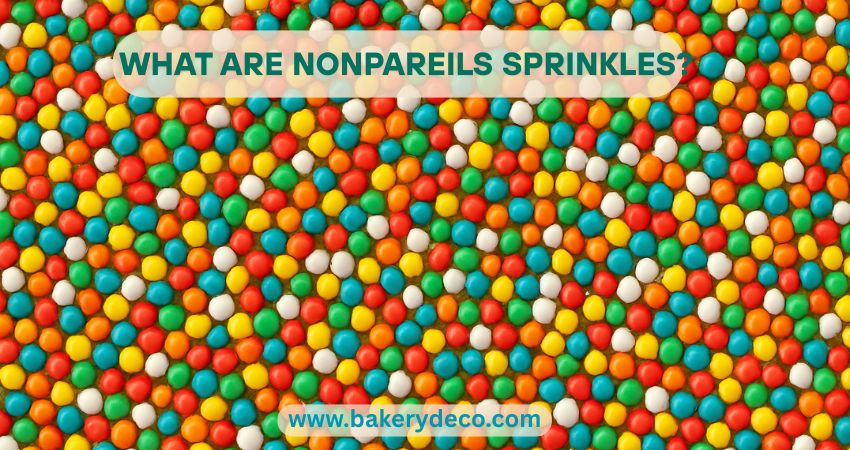
The Basics:
Traditionally used to ornament baked goods, nonpareils are tiny, round sugar sprinkles. The name stems from the French word "without equal," which is appropriate for these classic sweets.
· Other Names: Some nations (including Australia and the UK) call them "hundreds and thousands."
· Usually 1–2 millimetres in diameter, nonpareils are completely spherical balls far smaller than conventional elongated sprinkles, sometimes known as jimmies.
· Texture: Crisp, crisp, and melts when consumed.
What Are Nonpareils?
Nonpareils, usually spherical sugar balls called nonpareils, have been a staple confectionary embellishment for ages. In French, "nonpareil" means "without equal," suggesting their distinctiveness and maybe the secret ingredient they provide for sweets.
Composition and colours
Made mostly from sugar and cornstarch and covered with a hard candy shell that keeps their shape and colour even under heat during baking and food colouring, nonpareils Nonpareils provide baked goods with a festive and exquisite touch; they are available in a variety of hues and occasionally metallic finishes. Traditionally, sugar is heated and melted and then shaped into small beads. These beads are then coloured in a range of tones and rolled in starch. The result is a rainbow of fresh, sweet spheres ready to accentuate any delight.
How Are Nonpareils Made?
Nonpareil sprinkles are made from just a few basic components, which:
✔ Sugar: The primary element
✔ Cornstarch (to stop adhering)
✔ Food colouring—for vivid colours—
The Manufacturing Method:
One finds melting sugar forming little droplets.
2. rolled to preserve the form in Cornstarch.
3. polished for a glossy finish and coloured.
Fun Fact: To colour certain gourmet nonpareils, use natural food dyes (such as spirulina or beet juice!).
Chocolate Nonpareils
A Popular delicacy known as "chocolate nonpareils" combines creamy chocolate with a crunchy, colourful coating by having a flat disk of chocolate topped with a layer of these tiny sugar balls.What are nonpareils’ sprinkles ingredients?
Though they seem complicated, nonpareil sprinkles comprise a small number of simple elements. These small, vibrant candy decorations consist exactly of this:
Primary Ingredients in Nonpareils
1. sugar
Usually from sugar cane or beets, the major component is usually sucrose. Offers sweetness and shapes the basic structure.
2. Cornstarch
keeps the sugar beads from sticking together and gives nonpareils their round, smooth form.
3. Coloring Food:
Produces vivid colours—natural and synthetic. Typical synthetic colours: Red, blue, yellow
Natural substitutes: red beet juice, yellow turmeric, blue spirulina
4. Glazing Agents: Optional For gloss, some brands include confectioner's glaze—shellac. Plant-based waxes like carnauba wax may be used in vegan formulations.
Are nonpareils’ gluten-free? Vegan?
Gluten-free – No wheat components (however, check labels for cross-contamination warnings). Usually vegan – Though some have confectioner's glaze—derived from insects—most are plant-based.
Tip: Search for brands marked "vegan sprinkles" for vegan baking.
Uses of Nonpareil Sprinkles Usually used as a decorative topping; nonpareils are not blended into batters. Perfect for moist surfaces like melted chocolate or icing, they stick tightly to decorating biscuits, cupcakes, and cakes. Coating truffles and chocolate treats for a speckled appearance, roll cookie dough balls before baking. Include festive elements in holiday-themed sweets, including Halloween, Easter, or Christmas fare.
Making nonpareils creatively in Baking and Beyond
· Use nonpareils to make complex designs on royal icing biscuits or fondant-covered cakes, such as floral patterns or abstract art.
· Press nonpareils into homemade popsicles or yoghurt bark, then freeze for a crunchy, colourful surprise.
· For a sweet crunch, toss over caramelized nuts or dark chocolate-dipped pretzels for a savoury-sweet contrast.
· For a whimsical touch, coat the rim of dessert cocktails—such as espresso martinis or milkshake-inspired drinks—with nonpareils.
· Use waffles and French toast as a topping, or add to pancake batter just before flipping.
Nonpareils vs. Other Sprinkles: Special qualities
Structure: Jimmies (rod-shaped) and quins (flat discs) offer varied textures; nonpareils are the tiniest sprinkle type—tiny spherical balls.
Unlike sanding sugar, nonpareils dissolve faster than pearlized sprinkles but keep colour better when exposed to moisture (e.g., in buttercream).
Versatility: While larger sprinkles (like confetti quins) make bold statements, their small size lets one be exact in decorating.
Unlike soft sugar threads or melt-in-your-mouth dragees, nonpareils give a clear "crunch" when eaten.
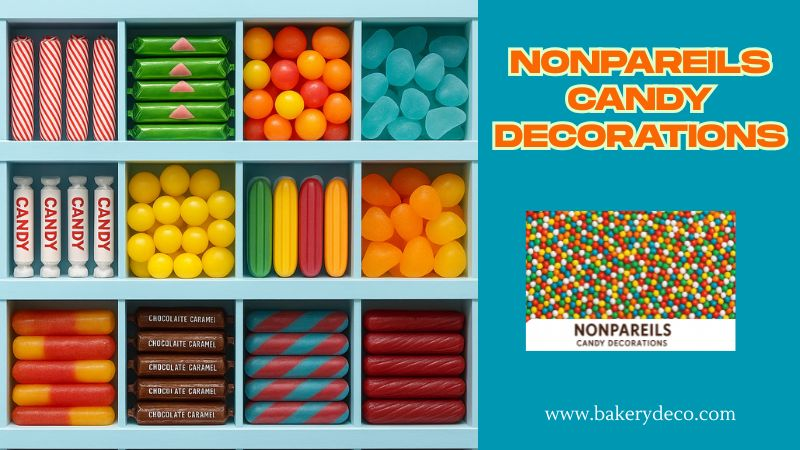
Beyond Cooking: Unanticipated Uses
Gourmet Cheese Boards: Scatter over goat cheese or brie drizzled with honey for a sweet-savoury contrast.
Salad garnish: For playfulness, toss in fruit salads or acai bowls in a pinch.
DIY Slime/Playdough: For a glitter-free substitute, mix it into kid-friendly sensory play objects.
Nonpareils Against Other Sprinkles: A Comparative and Useful Contrast
1) When decorating baked items and sweets, sprinkles give a wonderful texture and visual appeal. Still, not every sprinkle is made equally. Here's how nonpareils differ from popular variations such as jimmies, quins, and sanding sugar—and when you should grab each.
2) Celebrated for their crisp, crunchy texture and nonpareil sprinkles—tiny round sugar balls of only 1 to 2 are ideal for giving a pleasing crunch to chocolates, cupcakes, pastries, and delicate decorative elements. Although their colours remain vivid on top of chocolate or frosting, nonpareils are best used as a last touch rather than a baked-in component as blended into batter, they may bleed.
3) By contrast, jimmies—the traditional, soft, elongated flakes-have a chewy texture and keep their shape better when baked. Perfect for blending into cake batter, topping doughnuts, or adding texture to ice cream, they have a medium risk of colour leakage.
4) Quinns come to help those hoping to produce bold, festive decorations. Without a chance of bleeding, these flat, shaped decorations give cakes and pastries visual interest and strong colour. Quins are extremely popular for themed snacks when shapes like stars, hearts, or seasonal patterns are needed.
5) For those seeking a sparkling finish, sanding sugar—with its coarse, shimmering crystals—is the choice. Although pastries and desserts get a glittering, crunchy look from them, their high solubility causes them to disintegrate readily—especially in baked goods or moist environments.
Your sprinkling should ultimately complement your cooking objectives:
• For the complex intricacy and crisp texture of completed desserts, choose nonpareils.
• Select jimmies for baked items' and toppings' softness and durability.
• Choose bright colours to boldly and vibrantly declare on themed cakes.
• For pastries and cookies with glittering effects, use sanding sugar.
Every kind of sprinkle gives your sweets a unique character and turns basic sweets into amazing works of art.
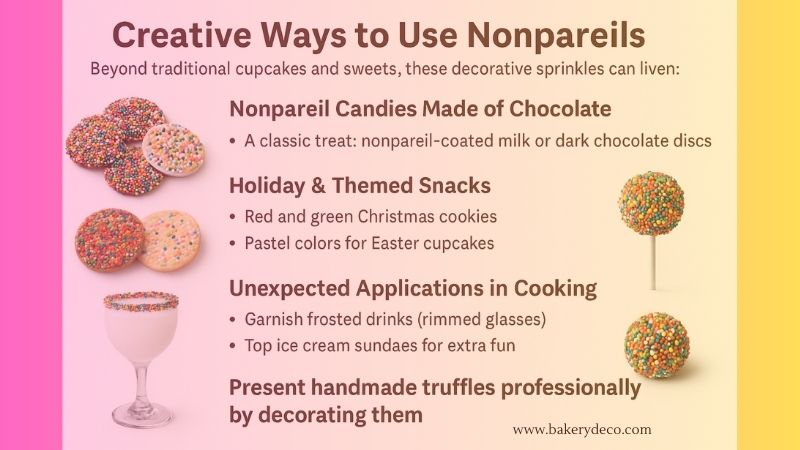
Present the handmade truffles professionally by decorating them.
The Science Behind choosing Nonpareil sprinkles
§ Unlike jimmies (cylindrical) or sanding sugar (irregular grains), nonpareils are small spheres whose uniform shape makes precise decorating possible. For complex designs, they are ideal.
§ Their mild crunch improves texture without overwhelming the taste.
Where to Buy Nonpareil Sprinkles
Buying Tips:
ü Grocery stores (baking sections)
ü Craft stores (like Michaels or Hobby Lobby)
ü Online (Amazon, specialized baking businesses)
They come in various hues; some specialized businesses even have unique colour combinations.
How to Store Nonpareil Sprinkles
§ Store in an airtight container (moist-free).
§ Store in a cool, dark environment; heat will melt them, preventing them from clumping together or melting.
§ Shelf Life: Under proper storage, up to two years!
Stored properly, they have a lengthy shelf life and are a great pantry staple for last-minute baking projects.
How do nonpareils affect the overall appearance of a baked good?
Nonpareils drastically improve baked goods by providing vivid color, whimsical playfulness, and a distinct speckled effect. Whether strewn over frosted cakes, cookies, or cupcakes or used to create patterns, borders, and even ombre effects by mixing different colors, their small, round form allows for detailed embellishment. Nonpareils stick nicely on moist surfaces like frosting or chocolate and produce an eye-catching, textured finish.
Their glossy, shiny surface gives desserts a festive and businesslike appearance, which enhances their inviting and joyful appeal. Nonpareils are especially popular for themed and seasonal desserts since their variety of hues fits any occasion. Nonpareils' colors can bleed when combined into batters or doughs, though, occasionally producing streaks or marbled appearances instead of discrete specks of color. They are most successful as a decorative topping for visual impact when applied to recently frosted surfaces or upon baking.
A French Confection with Timeless Charm
Close your eyes and picture something. Paris throughout the eighteenth century. Inspired by the night sky, a chocolatier creates small candy bits coated with edible "stars"—silver and gold sugar pearls. So, born nonpareils ("without equals" in French).
These sweets have grown today into chocolate discs enrobed in rainbow sprinkles, yet their magic remains. Let's unravel their narrative!
What Makes Nonpareil Candies Special?
1. The Signature Texture
Ø Chewy centre: sugar, corn syrup, gelatin (or vegan pectin).
Ø Crunchy shell: Originally metallic, then colorful with hundreds of small sugar beads
2. The Link between Chocolate
Modern nonpareils start with fine chocolate:
Ø The velvety traditional milk chocolate
Ø Rich in comparison to dark chocolate
Ø White chocolate is a delectable canvas for colors.
Fun Fact: Sugar beads keep their cornstarch coating crisp; they do not dissolve in your hands!
DIY Alert: Make Your Nonpareils!
Ingredients:
§ One cup of tempered chocolate
§ ¼ cup nonpareil sprinkles (or sugar + cornstarch + dye to make beads)
Process:
a) Melt chocolate and arrange it in thin discs.
b) Cover immediately with sprinkles.
c) Chill till set; voile!
Why DIY? Control the chocolate quality (try fair-trade cocoa) and colors (natural dyes = stunning hues).
Conclusion:
Whether your expertise is that of a professional pastry chef or home baker, nonpareils give pastries whimsical color and texture. Kitchen basics include adaptability, extended shelf life, and striking beauty.
Ready for decoration? Get a jar and sprinkle.
